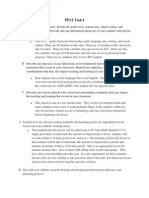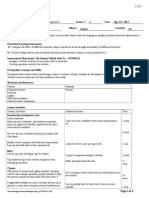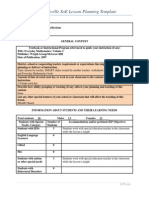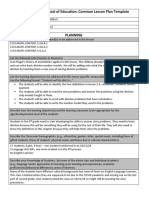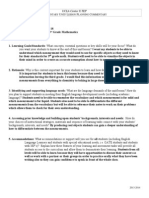Math 4-16 8 5
Math 4-16 8 5
Uploaded by
api-239430007Copyright:
Available Formats
Math 4-16 8 5
Math 4-16 8 5
Uploaded by
api-239430007Original Title
Copyright
Available Formats
Share this document
Did you find this document useful?
Is this content inappropriate?
Copyright:
Available Formats
Math 4-16 8 5
Math 4-16 8 5
Uploaded by
api-239430007Copyright:
Available Formats
UW-Platteville SoE Lesson Planning Template
Name: Jen Bajorek
Lesson Title: Customary Liquid Units
Grade level(s)/Course: 5th
Date taught:4/16/15
GENERAL CONTEXT
Textbook or Instructional Program referenced to guide your instruction (if any)
Title: Math Expression Common Core
Publisher: Houghton Mifflin Harcourt
Date of Publication: 2013
District, school or cooperating teacher requirement or expectations that might influence your
planning or delivery of instruction.
N/A
Amount of time devoted each day or week in your classroom to the content or topic of your
instruction.
90 minutes a day
Describe how ability grouping or tracking (if any) affects your planning and teaching of this
content.
Students are placed in a seating arrangement
List any other special features of your school or classroom that will affect the teaching of this
lesson.
The classroom has a Smart Board and the students are placed in groups.
INFORMATION ABOUT STUDENTS AND THEIR LEARNING NEEDS
Total students__13_______
Males__6________
Females______7____
Students with Special
Number of
Accommodations and/or pertinent IEP Objectives
Needs: Category
Students
Students with IEPs
2
Need directions and test to be read to them
English Language
Learners
Is not in the classroom for math (Pulled out to Special
Education Room)
Gifted
504
Students with autism
or other special needs
1|Page
UW-Platteville SoE Lesson Planning Template
Students with
Behavioral Disorders
INFORMATION ABOUT THE LESSON
Standards and Grade Level Expectations (GLE) CCSS.Math.Content.5.NBT.B.5.- Fluently multiply
multi-digit whole numbers using the standard algorithm. CCSS.Math.Content.5.MD.A.1- Convert among
different sized standard measurement units within a given measurement system and use these conversions
in solving multi-step real world problems.
Enduring Understanding and/or Essential Question: Customary Measure of Liquid Volume
Objective(s):
Students will comprehend the relationship between each customary unit by using
real life examples to complete conversions
Students will demonstrate knowledge of customary units by participating in
guided homework time as well as scoring higher than a 70 percent on their
homework.
DOK
3
Academic Language related to the lesson: gallon, quarts, pints, and cups
Prior Learning/Prior Thinking: The students have had two days of working with the customary unit
conversions. Today the students will be working with liquid units, it will be the first day of understanding
the units however they should be able to convert easily once knowing the amounts.
LESSON IMPLEMENTATION
Procedures
1. Anticipatory Set (Review/Preview): The students have a discussion about what are different
types of customary units and what are examples.
2. Purpose Statement: Today students we will be converting liquid units today liquids in the
United States.
3. Before starting the liquid conversions the students will convert lengths again (Review Sheet).
Give students about 10 minutes to complete. Then go over answers students will star if correct
and fix if wrong. This will be graded for effort and used for the teacher to assess how students are
doing with conversions.
4. We will start the day off by looking at the conversions for customary liquid units. The students
will open to page 247 in their activity workbook. The Smart Board will also have that page
projected on the screen. The teacher will point out the fractions use on the chart.
5. Together the class will go 247. The teacher will need to really explain the fractions part to the
students. This will be the first time the students have worked with conversions and fractions.
6. The students and teacher will also complete 248 together. The students will go up to the board ad
show how the work was done.
7. For homework the students will need to complete pages 165 and 166. They will have the
2|Page
UW-Platteville SoE Lesson Planning Template
remaining time in class to complete this work.
Closure: The students will need to hand in 165 and 166 tomorrow or when they finish the worksheet.
This will be graded and handed back.
Materials and Resources :Smart Board, 165/166, 247/248, pencil, and review sheet
Classroom Management/Democratic Practices:Students are expected to show respect for each other
and everything in the classroom. Students are also expected to turn in their work and do quality work.
ASSESSMENT
Formative
Summative
Before the lesson
The teacher will be reviewing the
liquid units as well as how to
convert the units.
The teacher will go over the
correct answer for the review
sheet with the students. The
students will mark wrong or
right. Teacher will collect to
asses students.
During the lesson
The teacher will be having
guided work time with the
students during this time the
teacher can assess the level of
understanding.
After the lesson
The students will be turning in
worksheet 165 and 166. The
teacher will grade these
assignments. If the students score
lower than a 65 the student will
need to make corrections.
3|Page
UW-Platteville SoE Lesson Planning Template
Reflection
After teaching the lesson I realized the students need more work with converting customary
units. I thought since we had spent a great deal of time working with converting customary
lengths the students would grasp it is the same concept only different numbers. I also notice
many students had a hard time with the word problems and finding the important information to
use. I will be teaching a day two of this same concept we will be focusing tomorrow on the idea
that when you start at a smaller unit and go to a larger unit you divide and when you start large
and go small you multiple. Students will also start underlining the important words and circling
the important numbers in word problems to help slow the students down and think about the
question being asked.
4|Page
You might also like
- National University Lesson Plan Dec1 MDocument6 pagesNational University Lesson Plan Dec1 Mapi-320720255100% (1)
- Handwriting LessonsDocument122 pagesHandwriting Lessonspololaperez100% (2)
- Ppat Task 4Document7 pagesPpat Task 4api-122157048100% (1)
- Lesson Plan 160204 Scientific MethodDocument7 pagesLesson Plan 160204 Scientific Methodapi-309206763100% (1)
- Edt 313 Lesson Plan 1Document3 pagesEdt 313 Lesson Plan 1api-404820930No ratings yet
- Synopsis E.S.T Promotion 2019Document5 pagesSynopsis E.S.T Promotion 2019azeem wattoo100% (3)
- Unit 1Document2 pagesUnit 1api-262824283No ratings yet
- College of Saint Mary Lesson Plan Format With Lesson ReflectionDocument4 pagesCollege of Saint Mary Lesson Plan Format With Lesson Reflectionapi-312091622No ratings yet
- EDT 415 Fact FamiliesDocument5 pagesEDT 415 Fact FamiliesAnonymous CCUxmSNo ratings yet
- Claflin University School of EducationDocument4 pagesClaflin University School of Educationapi-216728214No ratings yet
- USF Elementary Education Lesson Plan Template (S 2014) - Grade Level Being Taught: Subject/Content: Group SizeDocument9 pagesUSF Elementary Education Lesson Plan Template (S 2014) - Grade Level Being Taught: Subject/Content: Group Sizeapi-228765898No ratings yet
- Direct Instruction 1Document6 pagesDirect Instruction 1api-314997078100% (1)
- Content Standard(s) Addressed by This Lesson:: STEPP Lesson Plan FormDocument8 pagesContent Standard(s) Addressed by This Lesson:: STEPP Lesson Plan Formapi-285174429No ratings yet
- Lesson PlanDocument4 pagesLesson PlanErin WhitakerNo ratings yet
- 1-Scoe Lesson Planning Template Fa23 2 1Document5 pages1-Scoe Lesson Planning Template Fa23 2 1api-583052012No ratings yet
- Ratios and Probability Lesson Plan 7th GradeDocument4 pagesRatios and Probability Lesson Plan 7th Gradeapi-309139011No ratings yet
- Edpr4100 Sciencesandslesson4sitesearchpart2Document4 pagesEdpr4100 Sciencesandslesson4sitesearchpart2api-252533855No ratings yet
- 4math Lesson 10 3Document5 pages4math Lesson 10 3api-236893416No ratings yet
- Phases of The Moon LessonDocument7 pagesPhases of The Moon Lessonapi-407871224No ratings yet
- Detailed Full Lesson PlanDocument6 pagesDetailed Full Lesson Planapi-234333471No ratings yet
- Direct Instruction Lesson Plan TemplateDocument2 pagesDirect Instruction Lesson Plan Templateacraver4694No ratings yet
- Lesson Plan Template Teacher: Content Area/Topic: Grade Level: Lesson Title: LessonDocument6 pagesLesson Plan Template Teacher: Content Area/Topic: Grade Level: Lesson Title: Lessonapi-284297713No ratings yet
- Full Practicum Lesson Template 9 2015 2Document6 pagesFull Practicum Lesson Template 9 2015 2api-336028113No ratings yet
- Observation4 1 1Document2 pagesObservation4 1 1api-352681889No ratings yet
- 2014-2015 ObservationDocument5 pages2014-2015 Observationapi-288051646No ratings yet
- An Introduction To The Matrix LPDocument3 pagesAn Introduction To The Matrix LPapi-315640417No ratings yet
- Tws 1Document8 pagesTws 1api-202780085No ratings yet
- Third Grade Math LessonDocument6 pagesThird Grade Math Lessonapi-591042996No ratings yet
- Plickers LPDocument4 pagesPlickers LPapi-312091622No ratings yet
- Domain 1: Planning & Preparation: ED 345 Calvin University Teacher Intern Lesson Plan TemplateDocument2 pagesDomain 1: Planning & Preparation: ED 345 Calvin University Teacher Intern Lesson Plan Templateapi-542306350No ratings yet
- Lesson Plan Design: Ccss - Math.Content.5.Nbt.B.7Document6 pagesLesson Plan Design: Ccss - Math.Content.5.Nbt.B.7api-323520361No ratings yet
- Ste Teacher Work Sample Website - Chance TorrenceDocument31 pagesSte Teacher Work Sample Website - Chance Torrenceapi-376266093No ratings yet
- Formal Observaton 2Document9 pagesFormal Observaton 2api-267980163No ratings yet
- Lesson 4 - AssessmentDocument3 pagesLesson 4 - Assessmentapi-265442361No ratings yet
- Lesson Plan 2 Algebra 2Document6 pagesLesson Plan 2 Algebra 2api-704050165No ratings yet
- Lesson Plan Design: Ccss - Ela-Literacy - Rf.2.3Document6 pagesLesson Plan Design: Ccss - Ela-Literacy - Rf.2.3api-323520361No ratings yet
- American History 8 - SyllabusDocument3 pagesAmerican History 8 - Syllabusapi-240328999No ratings yet
- EDT 415 Lesson PlanDocument2 pagesEDT 415 Lesson PlansarahNo ratings yet
- Math 8 Syllabus 14-15Document2 pagesMath 8 Syllabus 14-15api-262642625No ratings yet
- Converting Fraction RLPDocument7 pagesConverting Fraction RLPapi-241521494No ratings yet
- Stepp Review Activity 1Document6 pagesStepp Review Activity 1api-281839323No ratings yet
- Teacher: Ms - Dee Lesson Number:2 Lesson Title: KWL On Equality Grade/Subject: 5Document5 pagesTeacher: Ms - Dee Lesson Number:2 Lesson Title: KWL On Equality Grade/Subject: 5api-302389835No ratings yet
- Observation 5 ScienceDocument6 pagesObservation 5 Scienceapi-346507216No ratings yet
- Reflective Lesson MeasurementsDocument6 pagesReflective Lesson MeasurementsTiaraMiles34No ratings yet
- Tws 4 Assessment PlanDocument5 pagesTws 4 Assessment Planapi-177752973No ratings yet
- National University Lesson Plan Nov9 VDocument5 pagesNational University Lesson Plan Nov9 Vapi-320720255No ratings yet
- Evidence of Student LearningDocument43 pagesEvidence of Student Learningapi-294486031No ratings yet
- Lessonplan 5Document2 pagesLessonplan 5api-240087811No ratings yet
- Decimals UnitDocument10 pagesDecimals Unitapi-251198450No ratings yet
- Rachelle Evans Cope Lesson Plan Edu 201 Spring 2008Document10 pagesRachelle Evans Cope Lesson Plan Edu 201 Spring 2008api-406403661No ratings yet
- Blog Lesson Plan EDU505Document2 pagesBlog Lesson Plan EDU505cbarron1No ratings yet
- EDUC 4403B AssignmentDocument6 pagesEDUC 4403B AssignmentSteph KwokNo ratings yet
- Webster Format For Lesson Plan 1 MicrolessonDocument10 pagesWebster Format For Lesson Plan 1 MicrolessonVictoria WarrenNo ratings yet
- Lesson Plan 2websiteDocument4 pagesLesson Plan 2websiteapi-251077176No ratings yet
- Reflective Lesson Plan - Math - 2-3Document6 pagesReflective Lesson Plan - Math - 2-3dburns1No ratings yet
- t3l RJG CommentsDocument4 pagest3l RJG Commentsapi-242609249No ratings yet
- Swun Math Lesson 1 CommentaryDocument2 pagesSwun Math Lesson 1 Commentaryapi-245889774No ratings yet
- University of West Alabama 5E Lesson Plan Template: Approved January, 2013Document4 pagesUniversity of West Alabama 5E Lesson Plan Template: Approved January, 2013api-554310453No ratings yet
- Direct Instruction Lesson Plan Template WwiDocument4 pagesDirect Instruction Lesson Plan Template Wwiapi-285080423No ratings yet
- Learning Segment-Ela 2Document10 pagesLearning Segment-Ela 2api-254944388No ratings yet
- Recount Lesson Plan-Oct PracticumDocument5 pagesRecount Lesson Plan-Oct Practicumapi-282820976No ratings yet
- Earth Science Syllabus 2014-15Document5 pagesEarth Science Syllabus 2014-15api-260729142No ratings yet
- A Practical Roadmap to Organizing and Managing the Special Ed ClassroomFrom EverandA Practical Roadmap to Organizing and Managing the Special Ed ClassroomNo ratings yet
- PwstdlalignmentDocument1 pagePwstdlalignmentapi-239430007No ratings yet
- PksdsummaryDocument1 pagePksdsummaryapi-239430007No ratings yet
- Img 0001Document1 pageImg 0001api-239430007No ratings yet
- Img 0002Document1 pageImg 0002api-239430007No ratings yet
- Large Capacity Type2 2Document2 pagesLarge Capacity Type2 2api-239430007No ratings yet
- Standard 10Document3 pagesStandard 10api-239430007No ratings yet
- Tons 4' : 3a-Q!ee? +% I I (Ol IDocument1 pageTons 4' : 3a-Q!ee? +% I I (Ol Iapi-239430007No ratings yet
- Img 0001Document1 pageImg 0001api-239430007No ratings yet
- Img 0012Document1 pageImg 0012api-239430007No ratings yet
- Img 0009Document1 pageImg 0009api-239430007No ratings yet
- Mffiffi: Tur, MfuDocument1 pageMffiffi: Tur, Mfuapi-239430007No ratings yet
- Img 0011Document1 pageImg 0011api-239430007No ratings yet
- Img 0002Document3 pagesImg 0002api-239430007No ratings yet
- Img 0010Document1 pageImg 0010api-239430007No ratings yet
- Resume Bajorek 2015Document1 pageResume Bajorek 2015api-239430007No ratings yet
- Current TransDocument3 pagesCurrent Transapi-239430007No ratings yet
- Img 0002Document9 pagesImg 0002api-239430007No ratings yet
- Standard 8Document3 pagesStandard 8api-239430007No ratings yet
- Standard 7Document3 pagesStandard 7api-239430007No ratings yet
- Weekly Report 1Document2 pagesWeekly Report 1api-239430007No ratings yet
- Ec Weekly Progress Report Week TwoDocument2 pagesEc Weekly Progress Report Week Twoapi-239430007No ratings yet
- Img 0002Document1 pageImg 0002api-239430007No ratings yet
- GenaposohfDocument152 pagesGenaposohfanon_38056826No ratings yet
- Grade 3 EAU WorksheetDocument1 pageGrade 3 EAU Worksheetsunil kumar.gNo ratings yet
- PHD in Germany 2011Document8 pagesPHD in Germany 2011La VieNo ratings yet
- Progression 1 EssayDocument6 pagesProgression 1 Essayapi-272112996No ratings yet
- Shailesh J Mehta School of Management: Iit BombayDocument40 pagesShailesh J Mehta School of Management: Iit BombaySarvagya JhaNo ratings yet
- Resume 2016Document2 pagesResume 2016api-317598025No ratings yet
- SMI-Newcastle WestDocument2 pagesSMI-Newcastle Westapi-273340865No ratings yet
- Sagacious ResearchDocument39 pagesSagacious ResearchEmmanuel Boakye100% (1)
- Pakistan Studies: Paper 2 InsertDocument4 pagesPakistan Studies: Paper 2 InsertAhmad NadeemNo ratings yet
- Case-Smith 2011Document10 pagesCase-Smith 2011jose martinNo ratings yet
- Isleworth Town Primary SchoolDocument14 pagesIsleworth Town Primary Schoolandywl09No ratings yet
- UCB Proposal For Holders Lane/Pebble Mill Playing Fields - BackgroundDocument3 pagesUCB Proposal For Holders Lane/Pebble Mill Playing Fields - BackgroundMartin MullaneyNo ratings yet
- AchievementsDocument4 pagesAchievementsapi-532080614No ratings yet
- Office of Admissions: Application FormDocument2 pagesOffice of Admissions: Application FormEvanjo NuquiNo ratings yet
- Student Teaching ReflectionDocument5 pagesStudent Teaching Reflectionapi-241949549No ratings yet
- Program IP Month Celebration 2022Document2 pagesProgram IP Month Celebration 2022Francis RamosNo ratings yet
- Providing Performance Feedback To Teachers: A Review: Mary Catherine Scheeler, Kathy L. Ruhl, & James K. McafeeDocument12 pagesProviding Performance Feedback To Teachers: A Review: Mary Catherine Scheeler, Kathy L. Ruhl, & James K. Mcafeenatalia_rivas_fNo ratings yet
- Pearsall CV 2018Document5 pagesPearsall CV 2018api-301509872No ratings yet
- Villareal National High School: Appraisal Form #1: Checklist On Classroom ManagementDocument4 pagesVillareal National High School: Appraisal Form #1: Checklist On Classroom ManagementRichard L. GolongNo ratings yet
- History of Nursing - Raquenio-Trisha-DianneDocument9 pagesHistory of Nursing - Raquenio-Trisha-DianneTrisha Dianne RaquenioNo ratings yet
- The Boarder 09-14-21Document3 pagesThe Boarder 09-14-21Anonymous gH0Y8V0No ratings yet
- 2023 JSS-G7 Term 3 Mathematics MidTerm ExamDocument6 pages2023 JSS-G7 Term 3 Mathematics MidTerm Examabdijimaale558No ratings yet
- Table of Contents RPMSDocument3 pagesTable of Contents RPMSLovely FloresNo ratings yet
- 2015 Childhope Asia Philippines Annual ReportDocument24 pages2015 Childhope Asia Philippines Annual ReportchildhopeasiaNo ratings yet
- Teacher Planner For 2024 in Black & White School Doodle StyleDocument28 pagesTeacher Planner For 2024 in Black & White School Doodle StyleAnjela AprilNo ratings yet
- Educ 6 QuizDocument1 pageEduc 6 QuizAl BinnNo ratings yet


